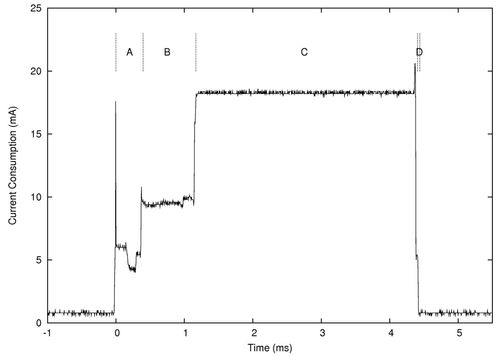IEEE802.15.4-2006
The IEEE802.15.4-2006 is the second revision of the standard, replacing the 2003 version. It standardizes both the physical layer (Layer 1, or PHY) and the medium access control layer (layer 2, or MAC). Designed for Low Power and Low Rate Personal Area Networks (WPANs), it has become the de-factor standard for WSNs.
The emphasis of IEEE 802.15.4 is to enable low-cost, low-speed ubiquitous communication between nearby devices with little to no underlying infrastructure. Its basic framework assumes 10-meter communications area at 250kbps. To meet embedded constraints, several PHY layers are available.
PHY
The features of the PHY layer are:
- low power operation
- low rate communication at 250kbps
- multi-channel support with a fast 192µs turnaround time.
- power management functions such as link quality and energy detection
The 2006 revision of the standard defines 4 PHY layers:
- 868/915 MHz DSSS with binary phase shift keying
- 868/915 MHz DSSS with offset quadrature phase shift keying
- 2450 MHz DSSS with offset quadrature phase shift keying
- 868/915 MHz PSSS, i.e. combination of binary keying and amplitude shift keying
In OpenWSN, we assume communication of the 2.4GHz worldwide ISM band. The IEEE802.15.4 standard divides this band into 16 2MHz channels separated by 5MHz. It employs a 16-ary quasi-orthogonal modulation technique. During each data symbol period, four information bits are used to select one of 16 nearly orthogonal pseudo-random noise sequences to be transmitted. The sequences for successive data symbols are concatenated. This technique, known as Direct-Sequence Spread Spectrum (DSSS), increases receiver jamming resistance (the standard requires an Adjacent channel rejection of 0dB). The aggregate chip sequence is modulated onto the carrier using offset quadrature phase-shift keying (O-QPSK).
The standard requires a compliant device to be capable of achieving a sensitivity of 85dBm or better. In practice, chips achieving sensitivities between -95dBm and -100dBm are commonplace. OpenHardwareSoftware lists popular radio chips.
In IEEE802.15.4 radios, the modulator burns more power than the power amplifier. The result is that a 10x reduction in the output power of the radio is rarely coupled to a corresponding reduction in radio current. Although those radios have some type of transmit power control, often over two orders of magnitude or more, the difference in radio current is rarely greater than 2x.
As an example, take the measurements presented above, obtained from an eZ430-RF2500 board equipped with a CC2500 radio. Note how a roughly 300x drop in transmit power (from 1dBm=1.25mW to -24dBm=0.004mW) translates in only a 42% decrease of the radio's current consumption (from 27.9mA to 16.1mA).
Before the first bit can be sent or received on the radio, a long sequence of events must typically take place inside the radio. From a deep sleep state, this entrails turning on a voltage regulator, waiting for a crystal oscillator to stabilize, and waiting for the radio oscillator to settle (tune) to the proper frequency, among other things. The figure above shows how a CC2500 radio takes roughly 1ms to switch between OFF and RX modes. The annotated phases are radio startup (A), radio frequency calibration (B), reception mode (C) and entering sleep (D).
MAC
The features of the MAC layer are:
- real-time suitability by reservation of guaranteed time slots
- collision avoidance through CSMA/CA
- integrated support for secure communications (128-bit AES encryption)
- star and mesh topologies can theoretically be built
- support for low-latencies and dynamic device addressing
The IEEE802.15.4-2006 standard comes with a MAC protocols, which defines two channel access methods.
The Non-Beacon mode is a simple, traditional multiple access system used in simple peer networks. Medium access conflicts are resolved through standard CSMA. Successfully received packets are positively acknowledged.
The Beacon-Enabled mode follows a superframe structure, where a network coordinator transmits beacons at predetermined intervals. As shown below, following this beacons comes a Contention Access Period (CAP) where neighbors of the coordinator can talk to it following a slotted Aloha medium access scheme. During that period nodes can request a dedicated time slot in the Guaranteed Time Slot (GTS) period following the CAP.
IEEE802.15.4-2006 defines two device classes. The Full Function Device (FFD) is capable of participating in any topology, when it can play the role of network coordinator; it is capable of talking to any other device. The Reduced Function Device (RFD) can only participate in a star topology, can only talk to a network coordinator, and cannot become a network coordinator. While the idea is for a RFD to require less hardware resource, in practice all IEEE802.15.4-2006 devices are FFDs.
The MAC protocol of IEEE802.15.4-2006 is well suited for simple star topologies, and was designed for application such as light automation: in a room, the light bulb plays the role of network coordinator; a couple of light switches are in the same room, together forming a star network. While IEEE802.15.4-2006's MAC protocol enables the formation of extended multi-hop stars, such topologies suffer from the fact that many of nodes in the network need to have their radio always on (hence a duty cycle of 100%), and that communication in the network happens on a single channel.
The goal of the IEEE802.15.4-2006 working group is to redesign the MAC protocol.


